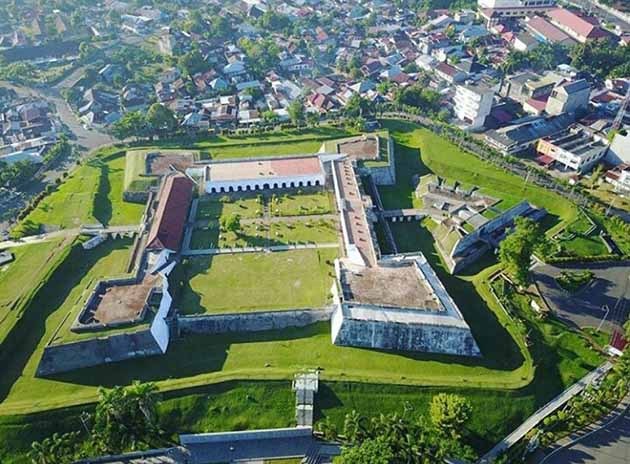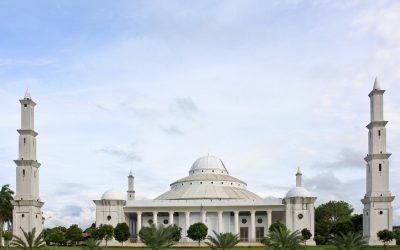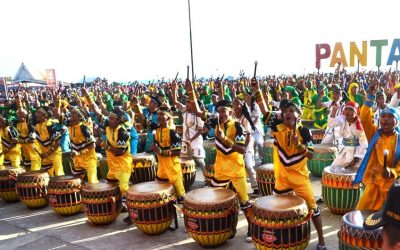Home / Batik Regions – Western Indonesia – Southern Sumatra – Bengkulu / Fort Marlborough
Cultural Destination
Embrace the spirit of the place!
Fort Marlborough
Fort Marlborough in Bengkulu was once built by the British colonial era during 1713-1719 under the leadership of Governor Joseph Callet. After the Fort George in Madras, India, Fort Marlborough lined up as the biggest British fortress in Southeast Asia. The total area of this building is around 44,100 square meters and surrounded by 8.5 meters-height walls. This fort has a unique character as it looks like a turtle-shaped building as seen from above.
Tourist Attractions in Bengkulu
At Taqwa Grand Mosque
Bengkulu also offers spiritual tourism with historical nuances and
Tabut Festival
Bengkulu regional government holds annual the Tabut Festival that takes place in
Bengkulu
Batik Motifs
Kaganga Tanah Rejang
If Batik Besurek combines Arabic calligraphy motifs, then the Kaganga batik takes
Besurek Rafflesia
The term “Basurek” refers to a textile that contains letters or inscriptions
Besurek Rembulan
This batik illustrates praise for God who created the wonderful universe
Discover
Indonesian
Batik
Motifs
Tongkonan
Toraja’s traditional house is called Tongkonan. Tongkonan is a place for
Daun Simpor
This motif is inspired by the Simpor plant (Dillenia Suffruticosa) which is a typical
Awan Berarak
Awan Berarak is a combination of Dayak motifs and Malay patterns. The word ‘Awan Berarak’ means the
Bomba Mawar
This motif means sacred love for family, kingdom, and God; It also illustrates
Wakatobi
It symbolizes the coastal beauty of the Wakatobi island and the symbol of Patra symbolizes
Raja Ampat
Raja Ampat motif represents the marine life at Raja Ampat archipelago in
Bale Lumbu
This motif signifies the welfare of the ancient Sasak society. Bale also symbolizes the
Dayak Taghol
Dayak Taghol has a distinctive style of four curved lines and small dots. This motif represents
Merak Ngeram
The hatching peacock motif has a very deep meaning which refers to the sacrifice and
Manguni Minahasa
Manguni is identified as the symbol of the Minahasa people. Manguni is known as a
Tangerang Herang
Tangerang Herang motif is a symbol of Tangerang city. The Tangerang Herang batik motif consists of
Tampuk Manggis Sasirangan
The motif illustrates the philosophy of the mangosteen fruit, which is
Karawo Pinang
Pinang refers to the Palm areca tree. This motif is considered as the original
Srimanganti
The name of the Srimanganti motif is derived from Palace’s hallway that connects to
Gamolan
This motif illustrates Gamolan, a bamboo musical instrument of Lampung that is
Tifa Totobuang
The batik motifs illustrate Maluku’s traditional music instrument called
Dayak Kamang
Kamang motif is generally found in the Dayak tribe shield because it is believed to
Mahkota Siger
Siger is the crown of a noblewoman in ancient time. It is a symbol of femininity, strength, and
Biji Kopi
The coffee seeds motif illustrates the pride of local coffee specialities in
Kain Cual
Cual textile tradition has existed since the 17th century. The word “Cual” refers to
Pohon Hayat (Tree of Life)
The Batik motifs in Lampung are dominated by the acculturation of Buddhist and
Paqbarre Allo
The word “Barre” means round and “Allo” means the sunlight. This motif is interpreted as
Malinau Cultural Festival
You will witness a unique competition that might not be found other than in
Angsa Duo
According to legend, the Angso duo batik motif is a pair of swans that are believed to have led Princess
Tikar Natuna
The Tikar Natuna motif is adapted from the traditional making of pandanus mats in
Cengkeh
The clove flower motif is the main commodity of the Tolitoli Regency. This motif represents
Sero Tangga
The Sero Tangga illustrates an endearing feeling and sacrifices of a person to fulfil
Daun Lada Hitam
The black pepper motif represents the main commodity of Bangka Belitung
Leuit Sijimat
This motif reflects the daily activities of the Baduy tribe in Banten. The main ornaments of batik motif consist of:
Jumputan Bintang
The word Jumputan means the tie-dye technique, while the word “Bintang” refers to
Rumah Mamuju
the Batik motif illustrates the house of Mamuju King with the stairs, located on the left of the wooden stage house
Salakanagara
Salakanagara batik motif illustrates the first kingdom in the Betawi land
Lontara
The Lontara script itself is a typical ancient script of Bugis and Makassar communities. History records that
Ake Patra
Ake is related to the divinity and the composition of the universe. It is a symbol of
Tanah Liek
The word “Tanah Liek” refers to clay in Minang language. It is also known as
Durian Pecah
Broken Durian motifs depict the foundation of faith. The second half signifies the mastery of
Gedhog Kembang Waluh
a combination of Javanese cultural motif of the Majapahit kingdom (XII-XIV century) with
Besurek Rembulan
This batik illustrates praise for God who created the wonderful universe
Sekomandi
Its philosophical meaning is the eternal union which refers to a saying “until death do us part”
Besurek Rafflesia
The term “Basurek” refers to a textile that contains letters or inscriptions
Ikan tambal
The word “Ikan” refers to fish. The philosophical meaning of Ikan Tambal means is
Prada Papua
The word “Prada” in the Javanese-Indonesian dialect means a batik textile that
Sekar Jati
Sekar means flower and Jati refers to teak trees that symbolizes a strong mental character that
Sido Mulyo
Sidomulyo is one of the classical motifs, which is specifically used for the bride’s costume in
Tubo Kelapa
Coconut tree is a symbol of a good character and strong mentality. It illustrates the more success a person, the more
Lipaq Sabe
Lipaq Saqbe contains a simple geometric classical motif with various flower decorations. This textile is
Taiganja
Taiganja is a precious gold pendant that shows the social status of the Kaili family. It is
Burung Bidadari
Bidadari birds are endemic birds in Halmahera. This motif represents an
Hiu Taliyasan
Indonesia is also home to the world’s largest fish, the whale shark (Rhincodon typus). Hiu Taliyasan refers to
Kerawang Tegak Aceh
The Vertical Upright (Kerawang Tegak) Motif symbolizes a person who has a strong
Parang Seling
Parang Seling or “alternating daggers” is a royal batik motif. It is a feminine variant of
Pucuk Rebung Riau
Pucuk Rebung symbolizes heart determination in achieving goals, good luck, and
Desa Na Tolu
The Desa Na Tolu characteristic pattern symbolizes the Batak philosophy of existence and
Tenun Bima
The motifs are adopted from Bima woven textile. This pattern has received a great
Kasih Tak Sampai
‘Kasih Tak Sampai’ is an idiom in the Indonesian language which refers to
Gonggong Beruntun
This motif illustrates that a person should maintain a positive attitude and
Gentala Arasy
Built as high as 80 meters, the tower also highlights the historical side of
Lok Baintan Floating Market
As you can imagine, the most authentic thing is that you can buy things and even
Bintik Tujuh
The Bintik Tujuh (Seven Dots) motif has 7 white spots and green color gradation as
Gigi Haruan Lidi
The Gigi Haruan Lidi motif is taken from the name of the cork fish and is a symbol of
Sandeq
Sandeq Boat is a symbol of the maritime importance of the West Sulawesi region. The greatness of
La Galigo
La Galigo is a literary work of the Buginese Epic that has 300 thousand epic lines. It is considered even
Wirasat
Wirasat or divine inspiration is a gift from God. This inspiration is symbolized by
Singayaksa
The Singayaksa motif comes from the name of a place where Sultan Hasanuddin used to
Gurdo Solo
Gurdo or garuda bird is the mount of the Indian god Vishnu. As the Sun Bird,
Kaganga Tanah Rejang
If Batik Besurek combines Arabic calligraphy motifs, then the Kaganga batik takes
Honai
The Honai is inspired by the traditional house of the Papuan community living in
Gorga Simeol-Meol
The Gorga Simeol-meol is a pattern of plant tendrils. it is regarded as a symbol of longevity and
Rangkiang
The word “Rangkiang” refers to the rice granary in the Minangkabau language. It symbolizes
Gumin Tambun
Based on Hindu mythology, this motif symbolizes lucks, abundant wealth, and
Pala Salawaku
This motif illustrates the unique weapons of the Maluku region, namely
Daun Sirih
This motif illustrates betel leaves that are used by Lombok communities as traditional
Keluak Daun Pakis
The word “Keluak” is a Minang language which means twisted or tangled. The Motif of



